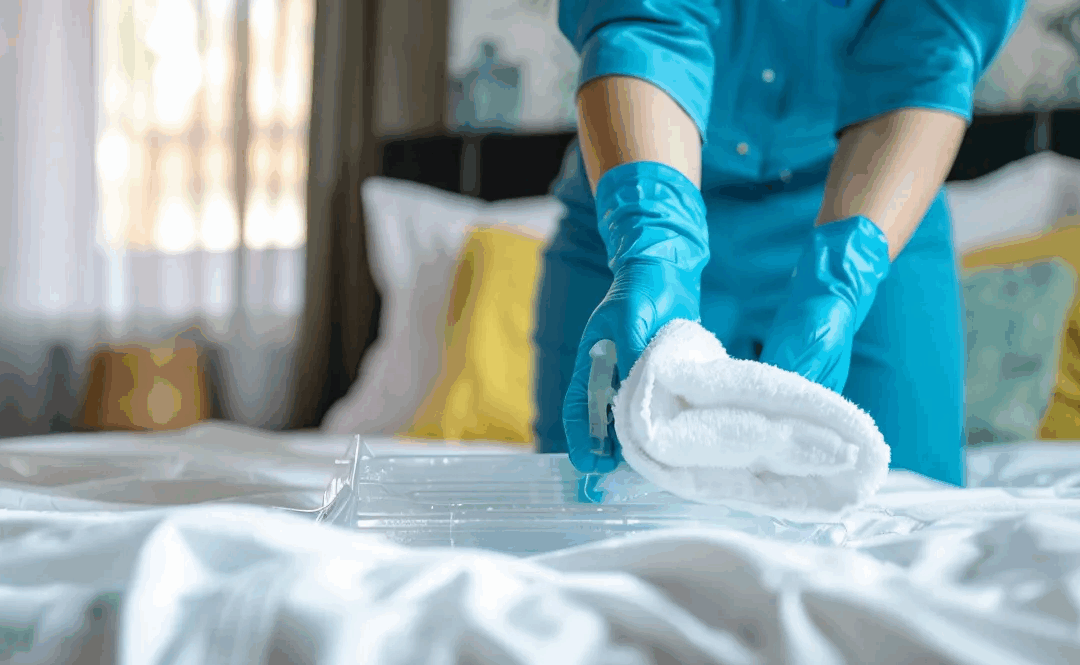Are nighttime allergies keeping you from deep, restorative sleep, leaving you congested by morning? Mattress cleaning for allergy relief targets the hidden reservoirs of dust mites, pet dander, mold spores, and pollen within your bedding. By removing these microscopic irritants, you can significantly improve air purity. This guide will walk you through why mattress hygiene is crucial, how often to clean, step-by-step DIY methods, when to enlist professional help, and long-term prevention strategies. Everything here is designed to help reduce your symptoms, enhance your indoor air quality, and promote truly restful sleep. For expert deep-cleaning solutions in Boise, trust Elevate Cleaning as your local partner in creating a healthier home.
Why Is Mattress Cleaning Essential for Allergy Relief in Idaho Falls?
Mattress cleaning is the process of removing allergens and microbial contaminants that accumulate in your bedding over time. This directly reduces immune triggers, promoting clearer breathing and better sleep. By extracting dust mite allergens and neutralizing mold spores, deep cleaning minimizes allergy symptoms and strengthens your overall respiratory health. Understanding this connection highlights the critical role of routine mattress maintenance in maintaining an allergen-free sleep environment.
Benefits of Mattress Cleaning for Allergy Sufferers
Regular mattress cleaning, whether you tackle it yourself or hire professionals, can significantly reduce allergen levels and improve your indoor air quality. This process involves removing dust mites, pet dander, and other common irritants, which can lead to a noticeable reduction in allergy symptoms and improved respiratory health.
Custovic, A., et al., “Domestic allergens and asthma.” (2000)
This citation supports our emphasis on the benefits of mattress cleaning for allergy sufferers and its positive impact on overall respiratory health.
How Do Dust Mites and Allergens Accumulate in Mattresses?
Mattresses are ideal habitats for microscopic dust mites, which feed on shed skin cells and thrive in warm, humid environments. Your body heat and skin debris naturally settle into seams and upholstery layers, creating prime nesting zones where allergens concentrate. Understanding these accumulation mechanisms empowers you to target deep-seated irritants with the right cleaning tools and techniques, preventing continued allergen exposure.
The Impact of Dust Mites on Allergies
Dust mites are a primary trigger for allergies. They feed on shed skin cells and flourish in warm, humid conditions. Exposure to dust mite allergens can manifest in various symptoms, including sneezing, nasal congestion, and itchy eyes, all of which can significantly disrupt sleep quality and overall respiratory health.
Arlian, L. G., et al., “Dust mite allergens: a review.” (2001)
This research validates our claims about the role dust mites play in triggering allergic reactions and underscores the importance of controlling their presence in your bedding.
What Allergy Symptoms Are Triggered by Mattress Allergens?
Exposure to irritants found in mattresses can provoke sneezing, nasal congestion, itchy or watery eyes, and skin rashes. For individuals with heightened sensitivities, dust mite proteins and mold spores can intensify asthma attacks, leading to chest tightness and chronic coughing. Recognizing the direct link between mattress allergens and these reactions clarifies why reducing contaminant levels leads to noticeable symptom relief and improved sleep quality.
How Does Mattress Cleaning Improve Indoor Air Quality and Asthma?
By effectively extracting and neutralizing airborne particles from your bedding fibers, professional or thorough DIY mattress cleaning significantly lowers indoor allergen concentrations. This, in turn, reduces asthma triggers and respiratory irritation. Cleaner mattresses contribute to overall air purity, supporting better lung function and potentially diminishing the need for frequent inhaler use. Enhanced air quality also benefits household members with compromised immunity or chronic respiratory conditions.
How Often Should You Clean Your Mattress to Reduce Allergies?
Cleaning frequency is a key preventive strategy that helps keep allergen levels below the thresholds that trigger symptoms. For allergy sufferers, performing a deep mattress cleaning every three to four months effectively interrupts dust mite lifecycles and prevents allergen accumulation that would otherwise worsen nasal and respiratory issues.
What Is the Recommended Cleaning Schedule for Allergy Sufferers?
Allergy experts recommend stripping and vacuuming your mattress monthly, complemented by a full deep-clean (either via steam or professional service) every three to four months. This regimen balances essential routine maintenance with periodic sanitization to ensure the ongoing removal of microscopic allergens before their populations can rebound.
How Does Regular Cleaning Prevent Allergen Build-Up?
Consistent vacuuming, prompt spot-treating of spills, and periodic sanitization effectively interrupt dust mite reproduction and clear away pet dander and mold spores before they can settle deeply into your mattress. Over time, this proactive approach lowers the baseline allergen load, reducing the severity of allergic reactions and contributing to sustainably cleaner air.
What Are the Best DIY Mattress Cleaning Tips for Dust Mite Removal?
DIY mattress cleaning involves using targeted tools and natural solutions to effectively remove dust mites, deodorize, and sanitize your sleep surface without resorting to harsh chemicals. By following a systematic process—gathering your supplies, vacuuming thoroughly, spot-cleaning, applying a baking soda treatment, and optionally using steam or UV-C sterilization, followed by complete drying—you can achieve significant allergen reduction and a fresher, cleaner bed.
Which Supplies Are Needed for Effective Mattress Cleaning?
Before you begin, gather these essential tools and cleaning agents that will help remove allergens while protecting your mattress’s integrity.
| Supply | Specification | Benefit |
|---|---|---|
| HEPA-filter vacuum | Upholstery attachment | Extracts microscopic dust and dander |
| Baking soda | Fine-grain, food-grade | Neutralizes odors and absorbs moisture |
| Enzyme-based cleaner | Plant-derived protease enzymes | Breaks down protein-based stains |
| Spray bottle | Adjustable mist nozzle | Even application of cleaning solutions |
| Microfiber cloths | Lint-free, washable | Gentle blotting without residue |
Each of these supplies addresses a critical aspect of mattress hygiene, preparing you for a thorough allergen removal process.
How Do You Vacuum a Mattress to Remove Dust Mites?
- Strip all bedding and launder your sheets at a high temperature (at least 130 °F or 54 °C).
- Attach the HEPA-filter upholstery nozzle to your vacuum and move slowly across the mattress fabric.
- Pay close attention to seams, tufts, and edges, as these are areas where dust mites tend to concentrate.
- Vacuum each side of the mattress for at least two minutes to ensure thoroughness.
- Empty or replace your vacuum filter immediately after use to maintain optimal suction and prevent allergen recirculation.
Thorough vacuuming removes the majority of dust mite debris, setting the stage for deeper deodorization and sanitization.
How Can Baking Soda and Natural Cleaners Help Deodorize and Sanitize Mattresses?
| Cleaner | Natural Ingredient | Function |
|---|---|---|
| Baking soda | Sodium bicarbonate | Neutralizes odors and absorbs moisture |
| White vinegar spray | Acetic acid solution | Breaks down mineral deposits and mold |
| Tea tree oil mist | Terpinen-4-ol extract | Antimicrobial action against fungi |
Sprinkle baking soda liberally over the mattress, allow it to sit for 30–60 minutes, then vacuum it up. Follow with an enzyme cleaner on any protein stains and a light mist of vinegar for mild sanitization, ensuring a fresher, safer sleep surface.
When and How Should You Use Steam Cleaning or UV-C Light for Mattress Sanitization?
Advanced DIY sanitization methods can offer deeper allergen eradication. Apply low-moisture steam at temperatures exceeding 130 °F (54 °C) to kill dust mites on contact, being careful to avoid over-saturation, which could damage mattress layers. Alternatively, expose the surface to a handheld UV-C lamp for two to three minutes per section to inactivate microbial spores. Both methods serve as powerful final steps after vacuuming and spot treatment.
How Should You Air Out and Dry Your Mattress After Cleaning?
- Position the mattress upright in a well-ventilated room or outdoors in indirect sunlight.
- Allow at least four hours of air circulation on each side.
- Use a fan or dehumidifier to speed up moisture evaporation, especially in humid climates.
- Confirm the mattress core is completely dry before remaking the bed to prevent mold development.
Ensuring total dryness preserves your mattress’s integrity and helps maintain an allergen-resistant environment.
When Is Professional Mattress Cleaning Recommended for Allergy Sufferers?
Professional mattress cleaning becomes essential when DIY efforts fall short of fully removing embedded allergens, stubborn stains, or persistent odors—particularly in cases of severe allergies or asthma. Trained technicians utilize industrial-grade extraction equipment, eco-friendly solutions, and specialized sterilization techniques to achieve a deeper level of sanitization than typically possible with home methods.
What Are the Benefits of Professional Mattress Deep Cleaning for Allergies?
- Enhanced allergen extraction through high-power HEPA filtration and hot water extraction.
- Thorough sanitization using steam or UV-C light at precisely controlled temperatures.
- Safe and effective removal of stubborn stains and odors with non-toxic, hypoallergenic solutions.
- Extended mattress lifespan thanks to comprehensive rinsing and protective treatments.
These benefits translate into measurable reductions in your home’s allergen load and sustained relief from allergy symptoms.
How Does Elevate Cleaning’s Mattress Cleaning Service Work in Boise, ID?
Elevate Cleaning’s mattress cleaning service begins with a complimentary inspection to assess your mattress’s condition and current allergen levels. Our technicians then apply eco-friendly pretreatments, perform HEPA-filtered vacuum extraction, and execute low-moisture steam or UV-C sanitization. A final protective spray is applied to guard against future dust mite growth. Clients receive a detailed before-and-after report outlining allergy reduction and recommended follow-up schedules.
What Eco-Friendly and Safe Cleaning Methods Are Used Professionally?
| Method | Technology | Allergen Control |
|---|---|---|
| Low-moisture steam | High-temperature vapor | Kills 99.9% of dust mites and bacteria |
| UV-C sterilization | Ultraviolet light | Inactivates mold spores and microbes |
| Plant-based solutions | Enzyme and citrus oils | Dissolves protein allergens and neutralizes odors |
These methods ensure a thorough, non-toxic cleaning process that aligns with health and environmental standards for Boise homes.
What Preventative Measures Can Help Maintain an Allergy-Free Mattress?
Achieving long-term allergy relief relies on adopting proactive habits and utilizing protective accessories that effectively block allergen ingress and inhibit dust mite proliferation. Implementing physical barriers, controlling your home’s environment, and performing regular maintenance can prevent irritant buildup and support ongoing respiratory comfort.
How Do Mattress Protectors Prevent Allergen Accumulation?
Allergen-proof mattress protectors feature tightly woven, breathable membranes that block dust mites and pet dander while still allowing air to flow. By sealing seams and encasing the entire mattress, these covers prevent new allergens from settling and trap existing irritants for easy removal during routine washing.
Why Is Regular Bedding Washing Important for Allergy Control?
Frequent laundering of sheets, pillowcases, and protectors at high temperatures (at least 130 °F or 54 °C) effectively eliminates up to 99% of dust mites and their associated allergens. Clean bedding serves as your first line of defense, reducing the transfer of irritants into your mattress fibers and preserving a healthier sleep surface.
How Does Humidity Control Affect Dust Mite Growth in Mattresses?
Dust mites thrive in humidity levels above 50%. Using dehumidifiers or air conditioners to maintain relative humidity between 30% and 50% disrupts mite reproduction cycles and prevents mold formation. Lower humidity also enhances overall comfort and inhibits microbial growth within your bedding materials.
What Role Does Pet Management Play in Mattress Allergen Reduction?
Limiting your pets’ access to bedrooms and regularly grooming your furry companions significantly reduces dander deposition on your mattress. Washing pet bedding frequently and vacuuming areas where animals spend time helps lower overall allergen presence and protects sensitive sleepers from exacerbated respiratory reactions.
When Should You Replace Your Mattress to Reduce Allergies?
Over time, mattress materials naturally break down, which can lead to persistent allergens becoming trapped deep within foams and fibers. Replacing your mattress every 7–10 years—or sooner if allergens remain despite professional cleaning efforts—ensures that you are not sleeping on a chronically contaminated surface.
What Are Common Questions About Mattress Cleaning for Allergy Relief?
Many homeowners often wonder whether mattress cleaning can entirely eliminate allergy triggers or simply manage symptoms, and which methods deliver the quickest relief. Understanding realistic expectations and effective techniques will help you choose the best cleaning strategy for sustained comfort and improved health.
Can Mattress Cleaning Cure Allergies or Just Reduce Symptoms?
Mattress cleaning effectively removes key environmental triggers but does not cure underlying allergy sensitivities. However, by significantly lowering dust mite and mold spore counts, it can reduce symptom frequency and severity, leading to more restful sleep and less reliance on medication.
What Kills Dust Mites Effectively in Mattresses?
High-heat steam (above 130 °F or 54 °C), hot-water laundering of bedding, and UV-C sterilization are proven methods that kill over 90% of dust mites on contact. Combining these methods with HEPA-filtered vacuuming offers comprehensive control of mite populations and their allergens.
How Long Does Mattress Cleaning Take to Improve Allergy Symptoms?
Many individuals notice symptom relief within 24 to 48 hours after a deep cleaning session, as airborne allergen levels decrease and breathing passages begin to clear. Ongoing maintenance and follow-up cleanings help sustain these improvements over time.
Are There Safe Cleaning Products for Sensitive Skin and Allergies?
Hypoallergenic, fragrance-free enzyme cleaners and plant-based detergents are ideal for minimizing irritation for sensitive sleepers. Always choose products labeled “non-toxic” and ensure thorough rinsing to remove any residue that could potentially trigger skin or respiratory reactions.
Can Mattress Cleaning Help with Asthma and Respiratory Health?
Yes, reducing indoor allergen loads significantly improves asthma control by limiting exposure to dust mite proteins and mold spores that commonly trigger bronchoconstriction. Cleaner mattresses contribute to better lung function and fewer asthma flare-ups.
How Does Mattress Cleaning Connect to Overall Home Allergy Relief?
Mattress cleaning is a crucial component of a holistic allergen-control strategy that should also include your carpets, upholstery, and area rugs. By addressing all fabric surfaces where dust mites and pet dander tend to accumulate, you create a consistently cleaner indoor environment that supports the respiratory health of your entire household.
Why Combine Mattress, Carpet, and Upholstery Cleaning for Total Allergy Control?
Allergen particles circulate throughout your home and settle on multiple surfaces. Coordinated cleaning of mattresses, carpets, upholstery, and rugs effectively disrupts allergen reservoirs at every level. To extend this comprehensive strategy, consider professional area rug cleaning to remove hidden dust and dander from your floor coverings and secure whole-home relief.
How Does Elevate Cleaning Support a Healthier Home Environment in Boise?
Elevate Cleaning offers specialized deep-cleaning services for carpets, upholstery, tile, grout, and mattresses, utilizing HEPA-filtered extraction, steam, UV-C light, and eco-friendly agents. Our certified technicians deliver measurable allergen reduction and ongoing maintenance plans specifically designed for Boise’s unique climate and lifestyle.
What Are the Benefits of Regular Professional Cleaning Across Home Fabrics?
Structured professional cleaning schedules prevent allergen rebound, protect your investment in home furnishings, and maintain optimal indoor air quality. Consistent service promotes a longer lifespan for your fabric surfaces, lowers long-term healthcare costs by reducing allergy symptoms, and ensures a more comfortable living environment for everyone, especially allergy sufferers.
Restoring an allergen-resistant sleep surface and combining it with comprehensive whole-home fabric care delivers complete allergy relief, better sleep, and improved respiratory wellness. Partnering with a local expert in Idaho Falls like Elevate Cleaning ensures you access advanced sanitization technologies and tailored protocols designed to safeguard your family’s health and comfort.






